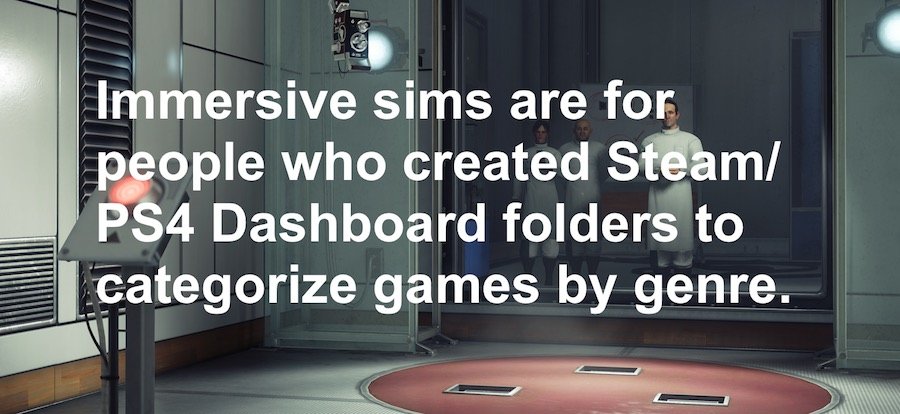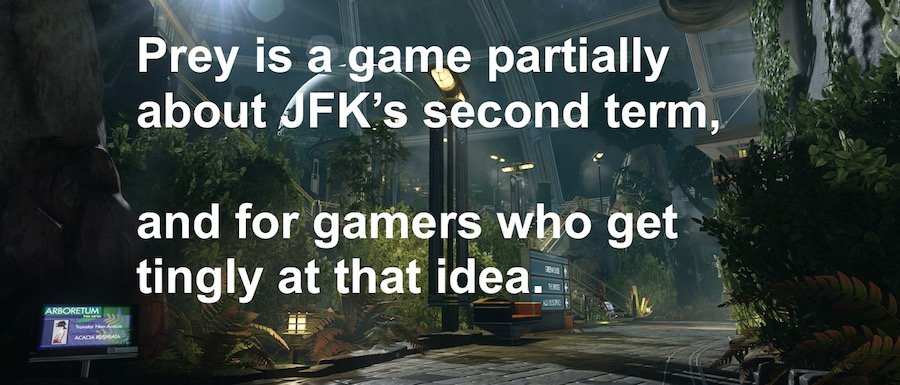Prey Is An Immersive Sim, I'm Told

Part One: The first hour of Prey
The week before Prey (2017) came out, I played a free downloadable Playstation 4 demo of the game with Zero Stars co-host and EIC, Bob. The demo takes you through the first hour and a half or so of the game. It’s a very good demo. I’m sure the developers at Arkane know that their game’s opening is strong - probably to a fault.
(And in fact, Prey itself is a good game, just to get that out there.)
Bob and I had issues with the demo. The first, we agreed, was that hitting monsters with your wrench didn’t feel good. The second was Bob’s alone: The Playstation 4’s DualShock controllers were too slow for what was, he said, “Obviously a love letter to PC gaming.” I sort of understood what he meant.
I grew up with Nintendo. Around the same time I got my Nintendo Entertainment System, Christmas of 1991, a neighbor gave us an old, hulking IBM with a floppy disc drive collection. I played Lode Runner (1983), a text adventure version of The Hobbit (1982) and a handful of other games using a cranky joystick with mysterious crumbs in its folds. I was more interested in the machine's word processor and trying to write Tolkien fan fiction.
My babysitter’s family had a nicer PC, and she and I played King’s Quest IV: The Perils of Rosella (1988) on that. I was enchanted by this game, first, because I was playing as a woman, and second, because it was so willfully weird. To put it nicely, those early Sierra adventure games are finicky - less nicely, many are aggressively shitty. The verb/noun-based text input was unfriendly, the puzzles obtuse, the random difficulty spikes unforgiving.
But the strange heft of this world struck me. I could wander around endlessly if I wanted. People would talk to me. Gnomes would talk to me. A frog would talk to me! And it had no consistent genre - part fantasy, part fairy tale, part horror story, and oddly self-aware. The game itself would talk to you, if it didn’t like what you had to type.
(My babysitter’s family also had a copy of Leisure Suit Larry (1987), another Sierra title, that rewarded frustration with pixelated nipples. It didn’t occur to me until just now how strange it was that a soft-porn title sat on the bookshelf next to Sim City (1989) and Civilization (1991), and I wonder if no one had struggled far enough through it to even discover the pixelated nipples and just figured it was as family-friendly as any PC game.)
I remained a Nintendo kid until I wasn’t a kid anymore, and then I was a Sony teen. PC gaming was outside my console-centrist purview. I knew it was there, I knew it could be impressive, but it didn’t fit my rhythms. Computers were for typing, for pass-the-time Shareware. By the time I was allowed to play DOOM (1993), I had GoldenEye: 007 (1997). I was acclimated to directional pads and sticks, to snappy friction, and the regimented cinematic storytelling of Final Fantasy. My logic: It was on a TV, so it should look like a movie.
The closest I came to emergent gameplay was trying to find an end to the infinite stream of soldiers at the end of Golden Eye: 007’s second level, The Facility. There was no end. I wasn’t immersed.
Meanwhile, just beyond my gaming echo chamber, people were being immersed by System Shock and Thief and Deus Ex. They even made up a genre name for that immersion.
What is an IMMERSIVE SIM?
Aesthetically, an immersive sim is a video game played from the first person perspective in which level/world linearity is looser, systems stack, AI is prioritized and some degree of physics is present. Together, these aim to deliver emergent gameplay. (Immersive Sims also really love grid-based inventories.)
The genre flagship is generally regarded to be Night Dive/Looking Glass Studio’s System Shock (1994). Modern iterations on the formula include Arkane Studio’s Dishonored series and Eidos-Montréal’s recent Deus Ex titles. The Bioshock games, starting with Bioshock (2008) are interesting remix of the immersive sim, insofar as they streamline many mainstays and prioritize (and arguably improve) combat. Bioshock is an arcade cabinet version of an immersive sim.
Immersive sims are for Neal Stephenson fans.
Immersive sims are games for people who might actually consider dating a computer, and no judgement, because computers are fucking cool.
Immersive sims are for people who created Steam/PS4 Dashboard folders to categorize games by genre.
What is EMERGENT GAMEPLAY?
Emergent gameplay, simply put, is when basic game systems interact with player agency to create unscripted outcomes.
For instance, if the story you are telling is “Claude and the Police Get in a Shootout” - that story might be told through emergent or linear gameplay.
Linear gameplay: The player, controlling ambitious Liberty City criminal Claude, is tasked with robbing a bank. In a narrative cutscene, an alarm is trigger and the police surround the bank. The player, as Claude, is in a shootout with the police.
Emergent gameplay: The player, controlling ambitious Liberty City criminal Claude, is distracted with his car radio controls and crashes a vehicle into the front of a bank. A patrolling police car responds. The police tell Claude (the player) to freeze. The player makes Claude run instead. The police pursue. Claude throws a grenade at them. They draw weapons. A shootout ensues.
Linear gameplay is the arrangement of overlapping systems.
Emergent gameplay is the chaos of overlapping systems.
Caveat
I have no idea what I’m talking about. I’ve never even played System Shock 2. These are the typings of an amateur pedant.

The most immersive games of my childhood were on a PC. They were King’s Quest (IV and VI (1992) especially), Myst (1993), Shareware like Hugo’s House of Horrors (1990) and even a hidden rom of Zork (1979(?)) on yet another inherited PC (this one nicer, running Windows 3.1). PC games seemed like novels rather than movies. They let you linger, tinker, revisit. In a sense, my memory of PC games isn’t even so much playing them but examining the boxes at my town Caldor. Strange missives from outside Nintendo.
(I have a strange, powerful longing to this day to play The Last Express (1997), a computer game I have never picked up and will never pick up, because the reality could never satisfy the immense longing I had to experience it.)
(Related: I have a thing for rotoscoped animation.)
So, back to the present, when Bob and I are playing the demoed first hour of 2017’s Prey by Arkane Studios, I agreed with Bob, thinking, “Yeah, it is like a PC game,” while totally misunderstanding what he meant.
To me, Prey was foreign, it was odd, it was just outside my reach. I played Prey and felt like it wasn’t something I should be playing on a console. It felt like a missive from outside Sony, Nintendo and the XBONE. Bob was right, it was a love letter to PC gaming. It was a love letter that wasn’t addressed to me, but I’d intercepted it on the way, and now I wanted to know the whole story, the whole correspondence.
What is Prey?
Prey is a first-person shooter immersive sim developed by Arkane Studios and published by Bethesda Softworks for the Playstation 4 (played), Xbox One and Windows PC (obvi).
The player-character is Morgan Yu (male or female; very cool), who explores a space station called Talos I, killing (a somewhat small roster of) alien monsters and saving or uncovering the emails/audio logs of the station’s (shockingly large) crew.
Prey has all the hallmarks of the original and Platonic immersive sim: It’s first-person, its world is largely non-linear, it has interactive physics, there’s RPG skill progression, AI is reactive, and there’s a megaton of text to read. Furthermore, the text is generally interesting. Furthermore still, the combat is generally gluey and-or clunky. DOOM shotguns, these weapons are not.
Prey is for people with a good mouse and keyboard.
Prey is for gamers who can read this review and not mind it’s being kind of unconstrained and a little sloppy, because there’s a striving for brilliance just under every surface.

To close my “review” of Prey’s opening hours: Find a friend with a copy of this game. Or download the demo. The demo is really excellent. Just listen to that helicopter music by Mick Gordon. Just witness the cleverness of those opening titles. Only a team working on their sophomore effort would have such hubris, such genius.
It’s a blast. Climb on blobs of glue! Run lab tests for your condescending brother! Explore your apartment! Explore your office! Read emails! Get chopped to bits by a helicopter blade by pure accident or morbid curiosity! Kill aliens with a wrench, if you must. Maybe avoid this game altogether if you have a fear of spiders! There’s even a really good twist about halfway through.
Prey’s opening hours are really good.

Part Two: The rest of Prey
I have played the opening hours of Prey five times. I have played the rest of Prey only once. I got the ending I got, and I looked the others up on YouTube. People seem divided about Prey’s ending(s). The twist(s) here can’t compare to the opening hour’s, and neither can the game. The core systems remain fun, but plot and an uncomfortable late-game linearity begin to strangle those systems. Eventually, it stops being fun.
Prey is a good game. It means well. It picks up the flag for immersive sims - whatever the hell that genre title even means - and marches on. It’s a PC game friendly enough to make a console appearance. It’s immersive, in a way even I can grasp through the lens of Sierra adventure titles. It’s emergent.
It also overstays its welcome, kind of like this review. ★